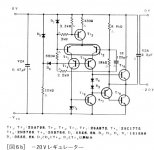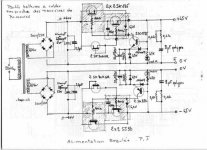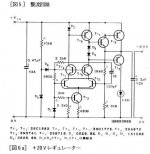KANEDA
Hi,
Jam,
I looked around for a diagram of the "Le Solstice" preamp,so far nothing turned up.
However here's an overview of everything that appeared in the "L'Audiophile" issues:
L'AUDIOPHILE
I have copies of most of them and have noticed quite a few articles are available on the French servers too.
You may be aware of this but quite a number of ISPs have been infected by the latest worm virus and are unavailable right now.
So be patient and I'll try to give a few links in a while.
If I seem to forget,just remind me.
Cheers,
Hi,
Jam,
I looked around for a diagram of the "Le Solstice" preamp,so far nothing turned up.
However here's an overview of everything that appeared in the "L'Audiophile" issues:
L'AUDIOPHILE
I have copies of most of them and have noticed quite a few articles are available on the French servers too.
You may be aware of this but quite a number of ISPs have been infected by the latest worm virus and are unavailable right now.
So be patient and I'll try to give a few links in a while.
If I seem to forget,just remind me.
Cheers,
This has indeed been a very good thread; my favorite in a while. 
This Kaneda 1995 preamp looks AMAZINGLY similar topologically to the Leach JFET preamp from the late 70's (look at this pdf, starting page 9 ) I built the RIAA stage many years ago and was very pleased with the sound, even using the lowly 2N5457 NJFets!
mlloyd1

This Kaneda 1995 preamp looks AMAZINGLY similar topologically to the Leach JFET preamp from the late 70's (look at this pdf, starting page 9 ) I built the RIAA stage many years ago and was very pleased with the sound, even using the lowly 2N5457 NJFets!
mlloyd1
jam said:Hartmut,
Thanks. That has been very helpful. I wonder if Jonathan Carr would care to comment. This has been a very useful thread.
Jam
FANS...
Hi,
Pass it on.
Seriously,this preamp has a lot of potential left untapped.
I said it before,I'm not into solid state devices but this preamp is one I could live with.
One the frenchies are back on their feet I'll search for more goodies.
Cheers,
Hi,
I shall have to talk to Mr.Pass about handing over a few of those famous fans.
Pass it on.

Seriously,this preamp has a lot of potential left untapped.
I said it before,I'm not into solid state devices but this preamp is one I could live with.
One the frenchies are back on their feet I'll search for more goodies.
Cheers,
Re: SOLTSTICE
quite the normal price, there has been one in Germany together with 30W Hiraga Le Classe A power amp for 1500 EUR, from a Swiss seller.
But you are right, they are quite rare, these both have been the only Solstice ads I ever have seen.
regards,
Hartmut
fdegrove said:
quite the normal price, there has been one in Germany together with 30W Hiraga Le Classe A power amp for 1500 EUR, from a Swiss seller.
But you are right, they are quite rare, these both have been the only Solstice ads I ever have seen.
regards,
Hartmut
Jam:
>What is your reason for using regulators for cascode biasing in place of zeners. Lower noise?<
Low noise in combination with a low and flat impedance curve.
>And what type of regulators do you use?<
I start out by looking at what I want to accomplish in terms of performance goals, and also at my budget in terms of circuit-board area, weight, heat, mechanical complexity, and monetary cost. I then come up with a regulator topology that is suited for the job. In the Connoisseur Definitions 4.0, which is the folded-cascode example that I kept in mind for the purposes of this thread, each amplifier module uses 12 regulators, so I have tried to keep each regulator relatively simple and compact. These are two-part series regulators using discrete semiconductors, with the first part of the regulator acting as a cascode for the second. There is a review of the Connoisseur 4.0 in the latest issue of HiFi+ (actually, it is part of the Boulder review), so you can read how these ideas translate into sonics in the real world.
Regarding the Kaneda amplifier circuits, there was another design generation where the active RIAA was driven directly from the collector of the second-stage sans follower. However, a summing current mirror was present under the second-stage differential.
Here (the circuit that Hartmut posted) it looks like Kaneda is trading some measure of simplicity and ease of construction for performance. No cascoding for the input JFET pair, and no attempt to stabilize the current sources feeding the second-stage differential (which has higher gain than the first differential).
regards, jonathan carr
>What is your reason for using regulators for cascode biasing in place of zeners. Lower noise?<
Low noise in combination with a low and flat impedance curve.
>And what type of regulators do you use?<
I start out by looking at what I want to accomplish in terms of performance goals, and also at my budget in terms of circuit-board area, weight, heat, mechanical complexity, and monetary cost. I then come up with a regulator topology that is suited for the job. In the Connoisseur Definitions 4.0, which is the folded-cascode example that I kept in mind for the purposes of this thread, each amplifier module uses 12 regulators, so I have tried to keep each regulator relatively simple and compact. These are two-part series regulators using discrete semiconductors, with the first part of the regulator acting as a cascode for the second. There is a review of the Connoisseur 4.0 in the latest issue of HiFi+ (actually, it is part of the Boulder review), so you can read how these ideas translate into sonics in the real world.
Regarding the Kaneda amplifier circuits, there was another design generation where the active RIAA was driven directly from the collector of the second-stage sans follower. However, a summing current mirror was present under the second-stage differential.
Here (the circuit that Hartmut posted) it looks like Kaneda is trading some measure of simplicity and ease of construction for performance. No cascoding for the input JFET pair, and no attempt to stabilize the current sources feeding the second-stage differential (which has higher gain than the first differential).
regards, jonathan carr
Jonathan,
Thanks for your insight into cascode biasing.
I have a copy of the Hi-Fi + article (older), they say it is the best preamp they have heard. (If only us mere mortals could afford such a device!).
Even more impressive is the lengths you go construct the unit, I took a gander at your web site. I urge the other members to take a look. (Lots of good construction ideas). It might give Peter Daniel some new ideas on chassis construction.

One last question. Do you use a single-ended or complementary output stage? Judgeing by the heatsinks attached to the output stage it must be biased pretty high.
Cheers,
Jam
Thanks for your insight into cascode biasing.
I have a copy of the Hi-Fi + article (older), they say it is the best preamp they have heard. (If only us mere mortals could afford such a device!).
Even more impressive is the lengths you go construct the unit, I took a gander at your web site. I urge the other members to take a look. (Lots of good construction ideas). It might give Peter Daniel some new ideas on chassis construction.

One last question. Do you use a single-ended or complementary output stage? Judgeing by the heatsinks attached to the output stage it must be biased pretty high.
Cheers,
Jam
jam said:It might give Peter Daniel some new ideas on chassis construction.

It already gave me some ideas. In my next preamp I will use 1/2" acrylic top cover.
I have to admit that the Connoisseur preamp is most thought out and no compromise design I've seen so far.
I wonder if not for the heat issues, carving the chassiss out of acrylic block would bring even better sonics?
Jam:
>I have a copy of the Hi-Fi + article (older), they say it is the best preamp they have heard.<
Please do read the review in the latest Hi-Fi+ if you can locate a copy. It will provide additional insight on the reasons why Roy Gregory likes the Connoisseur, and they are reasons that will appeal more to a music-lover than an audiophile.
>(If only us mere mortals could afford such a device!).<
Perhaps some day. In the meantime, have you looked at the Tom Evans Groove? It isn't nearly as outrageously priced as the Connoisseur, and the sound definitely goes in a similar direction (as you will also read in the current Hi-Fi+ review). And as far as I know, it is based on opamps. So there is hope.
In fact, my next project will be an opamp-based phono stage for Lyra, and it will be fun to see how close to the Connoisseur I can get. I wouldn't be at all surprised if the results turn out sounding more than a little like the Groove.
>Even more impressive is the lengths you go construct the unit.<
I enjoy coming up with at least one clever but wacky idea for each product that we do. That is part of how I have fun. I also believe in pushing yourself as far as possible. The knowledge, experience and personal progress that you make on each project becomes the starting point for your next project. If you want to learn and grow, push yourself - hard.
>Do you use a single-ended or complementary output stage? Judgeing by the heatsinks attached to the output stage it must be biased pretty high.<
Complementary. Those are low-capacitance FETs made for us by a company that specializes in custom semiconductor work. And you are right, the output stage is biased pretty high. You could probably continue touching the heatsinks for more than a few seconds, but I daresay that you would have to set your mind to it.
Peter: The Connoisseur 3.0 uses a power supply that runs at +/- 144V, and drops that down ultimately to +/- 35V in the regulators. As a result, those regulators run _hot, and there are multiple regulators used. With adequate ventilation, the entire chassis runs at around 47~48 degrees centigrade.
For a more conventional preamp design, I reckon that something like Micarta, tankwood, Fountainhead, polycarbonate, acrylic and so on should be fully adequate. Experience suggests that, as long as shielding and heatsinking is not a concern, the sound will be better if you minimize the use of conductive materials for chassis construction.
regards, jonathan carr
>I have a copy of the Hi-Fi + article (older), they say it is the best preamp they have heard.<
Please do read the review in the latest Hi-Fi+ if you can locate a copy. It will provide additional insight on the reasons why Roy Gregory likes the Connoisseur, and they are reasons that will appeal more to a music-lover than an audiophile.
>(If only us mere mortals could afford such a device!).<
Perhaps some day. In the meantime, have you looked at the Tom Evans Groove? It isn't nearly as outrageously priced as the Connoisseur, and the sound definitely goes in a similar direction (as you will also read in the current Hi-Fi+ review). And as far as I know, it is based on opamps. So there is hope.
In fact, my next project will be an opamp-based phono stage for Lyra, and it will be fun to see how close to the Connoisseur I can get. I wouldn't be at all surprised if the results turn out sounding more than a little like the Groove.
>Even more impressive is the lengths you go construct the unit.<
I enjoy coming up with at least one clever but wacky idea for each product that we do. That is part of how I have fun. I also believe in pushing yourself as far as possible. The knowledge, experience and personal progress that you make on each project becomes the starting point for your next project. If you want to learn and grow, push yourself - hard.
>Do you use a single-ended or complementary output stage? Judgeing by the heatsinks attached to the output stage it must be biased pretty high.<
Complementary. Those are low-capacitance FETs made for us by a company that specializes in custom semiconductor work. And you are right, the output stage is biased pretty high. You could probably continue touching the heatsinks for more than a few seconds, but I daresay that you would have to set your mind to it.
Peter: The Connoisseur 3.0 uses a power supply that runs at +/- 144V, and drops that down ultimately to +/- 35V in the regulators. As a result, those regulators run _hot, and there are multiple regulators used. With adequate ventilation, the entire chassis runs at around 47~48 degrees centigrade.
For a more conventional preamp design, I reckon that something like Micarta, tankwood, Fountainhead, polycarbonate, acrylic and so on should be fully adequate. Experience suggests that, as long as shielding and heatsinking is not a concern, the sound will be better if you minimize the use of conductive materials for chassis construction.
regards, jonathan carr
jcarr said:Complementary. Those are low-capacitance FETs made for us by a company that specializes in custom semiconductor work. And you are right, the output stage is biased pretty high. You could probably continue touching the heatsinks for more than a few seconds, but I daresay that you would have to set your mind to it.
[/B]
Jonathan,
Chris Postl from Freising near Munich posted on the German vinyl-lebt (vinyl lives) internet forum that he had your Connoisseur 4.0 phono preamp for a while and dislikes it because of it's noisy, and that he prefers the PASS XONO to your stuff.
Though Frank Schroeder (that Berlin tonearm guy) replied to him that probably it is because of the line stage, which has too much gain.
I always thought you had 100mS custom JFETs in the input ...
regards,
Hartmut
BTW, next time you are in Munich, stop by me, or we could meet at Willi Bauer's place.
Jonathan,
I will get a copy of the new Hi Fi+ article.
I, and speaking for other members of this forum, would like to thank you for sharing your ideas with us. This has been a most useful discussion on the practical aspects of pre-amp design. Maybe one day you might share some schematics of your earlier designs with us.
Cheers,
Jam
I will get a copy of the new Hi Fi+ article.
I, and speaking for other members of this forum, would like to thank you for sharing your ideas with us. This has been a most useful discussion on the practical aspects of pre-amp design. Maybe one day you might share some schematics of your earlier designs with us.
Cheers,
Jam
- Status
- This old topic is closed. If you want to reopen this topic, contact a moderator using the "Report Post" button.
- Home
- Source & Line
- Analog Line Level
- kaneda preamp




